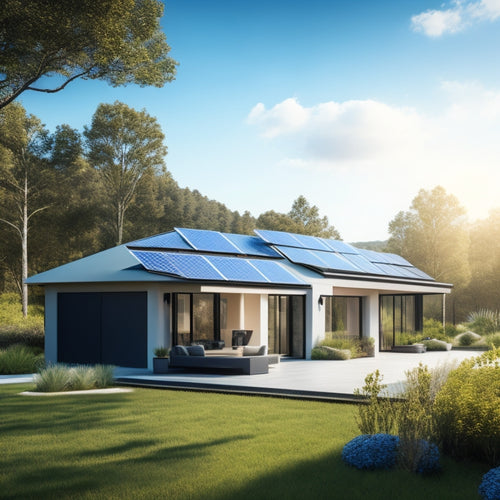
Installing Solar Panels on Your Home in 5 Easy Steps
Share
You're ready to utilize the power of the sun and switch to clean energy! Start by evaluating your home's solar potential, considering factors like roof size, orientation, and condition, as well as local building codes and energy usage patterns. Next, choose a solar panel system that fits your needs, evaluating efficiency, durability, and maintenance requirements. Then, prepare your roof for installation, ensuring it's structurally sound and ready for the panels. After that, install the solar panels, connecting them to form a complete array. Finally, connect to the grid, integrating your system with the local electric company to start generating clean energy and tracking your progress. Now, take the next step towards a solar-powered home.
Key Takeaways
- Assess your home's solar potential by evaluating roof size, orientation, and condition, as well as local building codes and energy usage patterns.
- Choose a suitable solar panel system based on factors like efficiency, durability, and warranty, considering monocrystalline, polycrystalline, and thin-film options.
- Prepare your roof by inspecting and maintaining its condition, ensuring structural integrity, and confirming compatibility with solar panel installation.
- Install solar panels securely and efficiently, using a suitable mounting system, and connecting them to form a complete solar array.
- Connect to the grid by installing a grid-tie inverter, net meter, and establishing a utility partnership, enabling safe and efficient energy transfer.
Assess Your Home's Solar Potential
Prior to investing in a solar panel system, it's essential to determine whether your home is a good candidate for solar power. You'll want to assess your home's solar potential to guarantee you can reap the solar energy benefits.
Start by evaluating your roof's size, orientation, and condition. A south-facing roof with minimal shading is ideal. Consider the local building codes and homeowners' association rules, as they may impact your installation.
You'll also want to analyze your energy usage and identify areas for improvement. Review your past electricity bills to determine your energy consumption patterns. This will help you determine the required system size and possible savings.
Don't forget to research the financial incentives available in your area, such as tax credits and rebates. These can greatly offset the upfront costs of your solar panel system.
Choose Your Solar Panel System
Selecting the right solar panel system for your home is a crucial step in utilizing the power of solar energy. You'll want to evaluate various solar panel types, each with its own strengths and weaknesses.
Monocrystalline panels offer high efficiency but are more expensive, while polycrystalline panels are more affordable but slightly less efficient. Thin-film panels are a budget-friendly option but have lower efficiency rates.
System efficiency is another critical factor to evaluate. Look for systems with high efficiency ratings, typically above 15%. Higher efficiency means more power generated per hour of sunlight, resulting in greater energy savings.
You'll also want to take into account the system's durability, warranty, and maintenance requirements.
When choosing a solar panel system, it's crucial to assess your energy needs and budget. Calculate your energy consumption and determine the size of the system required to meet your needs.
Be sure to research and compare different systems, considering the pros and cons of each before making a decision. By selecting the right solar panel system, you'll be well on your way to utilizing the power of solar energy and reducing your reliance on traditional energy sources.
Prepare Your Home's Roof
With your solar panel system chosen, it's time to turn your attention to preparing your home's roof for installation. Before you can reap the benefits of solar power, you need to guarantee your roof is ready for the added weight and structural demands of the panels.
Inspect your roof's condition, looking for signs of wear, damage, or aging. Check for loose, missing, or damaged shingles, curled or buckled shingles, and signs of animal or insect infestation.
Perform any necessary roof maintenance to guarantee a solid foundation for your solar panels.
Next, consider the type of roof materials you have. Different materials, such as asphalt, metal, or tile, may require special considerations or additional installation steps.
Confirm your roof's structural integrity can support the weight of the solar panels, and that the materials are compatible with the panel's mounting system.
Install the Solar Panels
You're now ready to install the solar panels on your prepared roof. The type of solar panels you've chosen will affect the installation process. There are two main solar panel types: monocrystalline and polycrystalline. Monocrystalline panels are more efficient but also more expensive, while polycrystalline panels are less efficient but more affordable.
| Solar Panel Type | Installation Cost |
|---|---|
| Monocrystalline | $2.50 - $3.50 per watt |
| Polycrystalline | $2.00 - $3.00 per watt |
| Thin-Film | $1.50 - $2.50 per watt |
Once you've decided on the type of solar panels, it's time to begin installation. Start by securing the mounting system to your roof, making sure it's level and securely fastened. Next, attach the solar panels to the mounting system, ensuring they're properly aligned and connected. Finally, connect the panels to each other, forming a complete solar array. Remember to follow all safety precautions and local building codes during the installation process.
Connect to the Grid
One essential step in utilizing solar energy is connecting your newly installed solar panels to the grid. This process, known as grid integration, allows you to sell any excess energy back to the utility company and offset your energy costs.
To connect to the grid, you'll need to establish a utility partnership with your local electric company. This partnership enables the flow of energy between your solar panels and the grid.
You'll need to install a grid-tie inverter, which converts the DC power from your solar panels into AC power, making it compatible with the grid. The inverter will also monitor the grid's voltage and frequency, ensuring a safe and efficient energy transfer.
Additionally, you'll need to install a net meter, which tracks the amount of energy you produce and consume. This meter allows you to sell any excess energy back to the utility company and receive credit on your energy bill.
With a successful grid integration, you'll be generating clean energy and reducing your reliance on the grid.
Frequently Asked Questions
Can I Install Solar Panels on a Rented Property?
You'll need to check your rental agreements and obtain your landlord's permission before installing solar panels on a rented property, as modifications to the property typically require their consent.
How Long Does a Typical Solar Panel Warranty Last?
Coincidentally, you're wondering about warranty length just as you're about to invest in solar power! Typically, a solar panel warranty lasts 25 years or more, covering defects and performance guarantees, ensuring your solar panel lifespan is protected and your investment pays off.
Are There Any Local or State Incentives for Solar Installation?
You'll likely find local and state incentives for solar installation, such as federal tax credits and solar rebates, which can greatly reduce your upfront costs, making your shift to renewable energy more financially appealing.
Can I Sell Excess Energy Back to the Utility Company?
You imagine a sunny day, your solar panels soaking up rays, generating more energy than you need. With net metering benefits, you'll sell excess energy back to the utility company through energy buyback options, offsetting your bill and padding your wallet.
Do Solar Panels Increase My Property Taxes?
You're wondering if solar panels will hike your property taxes. The good news is that, in most states, increasing your property value with solar won't directly impact your tax assessment, so you won't see a significant tax spike.
Conclusion
You've taken the leap and installed solar panels on your home - congratulations! Now, bask in the glow of renewable energy and watch your utility bills dwindle like autumn leaves. With your new system up and running, you're not only saving money, but also doing your part for the planet. As you utilize the power of the sun, you'll be beaming with satisfaction, knowing you've made a smart investment that will shine bright for years to come.
Related Posts
-

Evaluating Solar Power Options for Businesses
Evaluating solar power options for your business can greatly reduce energy costs and enhance sustainability. Start by...
-

Solar Power Backup Solutions During Outages
Solar power backup solutions guarantee you have reliable energy during outages, providing essential power when the gr...
-

Eco-Friendly Energy Storage Systems for Houses
Eco-friendly energy storage systems for your house let you capture and use renewable energy efficiently. You can choo...


